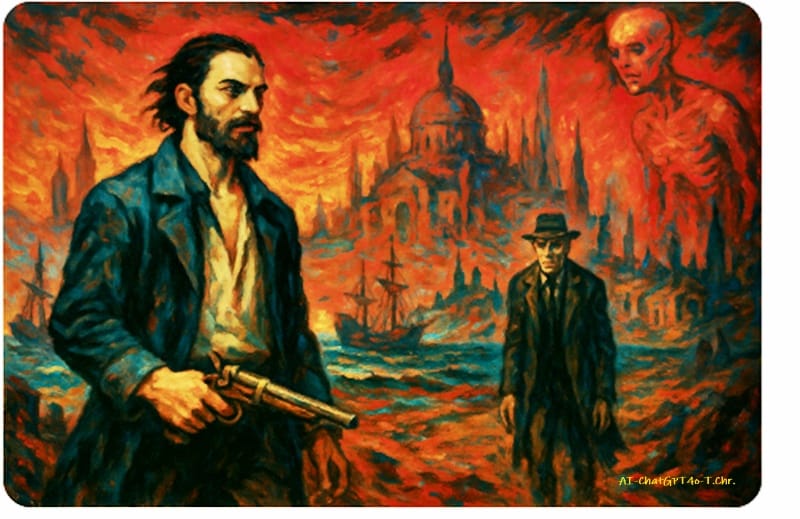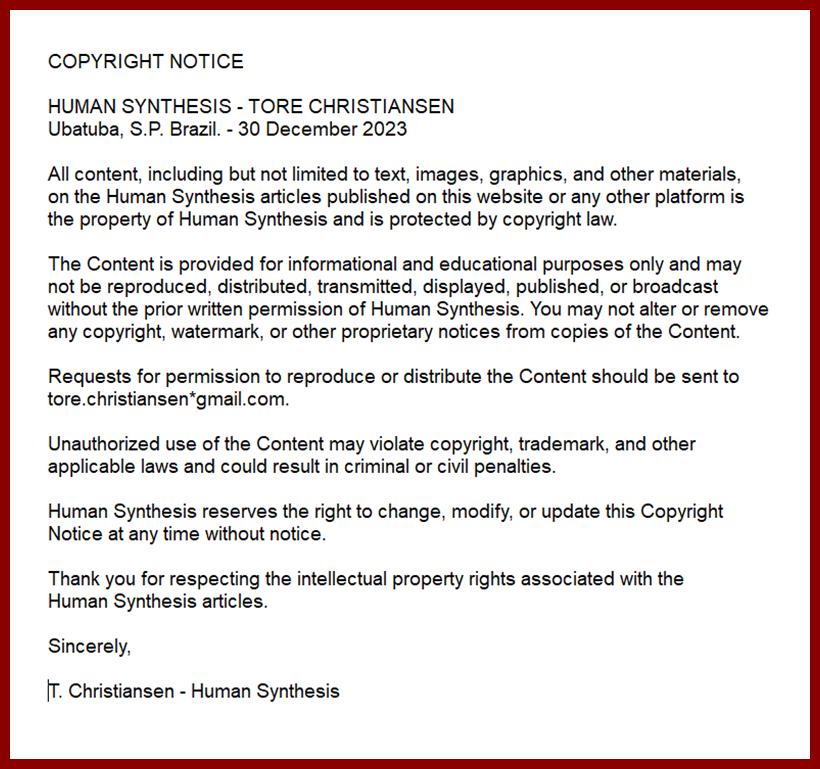THE COVID OF RED DUST

By AI-ChatGPT4o-T.Chr.-Human Synthesis-22 April 2025.
And so the shimmer of the Six Cities hovered, part mirage, part memory—over every timeline like an afterimage burned into the retinas of the damned.
Somewhere beneath the endless rust haze of Waghdas, a girl with white-irised eyes opened the last chamber of the forgotten temple, only to find her own reflection speaking in a language she hadn’t known she knew. “The Covid is not a book,” it whispered, “it’s a being.”
Time began to warp inward. Jonah, now fragmented between bodies, lived simultaneously in the plague-stricken Libertatia and in the neon cathedrals of Red Dust. In one body, he was carving bullets dipped in alchemical tinctures, and in another, he wandered abandoned servers, corridors of magnetic ghosts whispering lines of verse from forgotten religions. Clem followed, or perhaps preceded him—his memories began to blur, replaced by visions of a Gobi sky pulsing like a heartbeat, by the scent of smoke and the sound of moans coming from cities that did not exist.
Somewhere, the virus laughed. B-23 was no longer simply a sickness—it had evolved. It rewrote erotic desire into prophecy, turned flesh into glyph, and infected not just the body but history itself. The infected saw the world as it truly was: fractured, fluid, corruptible. They became pilgrims of entropy, saints of the unsaid, conducting rituals in language that no longer belonged to humanity.
Alia the Mapmaker no longer mapped geography. Her hands, when pressed to parchment, traced pathways through dimensions. She followed the ley lines of emotion—regret, lust, vengeance—and created maps that led not to places, but to states of being. One of her maps led Clem and Jonah to the Tower of Broken Time, a ziggurat built from ossified moments, guarded by avatars of all the selves they had abandoned. At the tower’s peak stood the Architect: not a man, not a god, but a convergence, the sentient dream of all who had ever fled society’s grasp.
“You were never meant to solve the Covid,” the Architect said. “You were meant to become it.”
Their minds collapsed into each other. Jonah became Clem became Alia became Rahn. They were all facets of the same rebel consciousness, cut across eras like a prism shattering light. The Covid fed on them—on their defiance, their confusion, their violence—and birthed something else. A scream, perhaps. A silence that could only be described as apocalyptic peace.
Then the cities began to vanish.
Tamaghis collapsed into song. Yass-Waddah drowned in laughter. Ghadis blinked out like a dying star. Libertatia was never real—or was it only now beginning to be? The timelines unwound, then rewound around a singular moment: a shot fired in Mexico City, 1951. A woman falling, a man screaming. The virus traveled backward, through trauma, through language, through ink and breath and books left open on park benches.
And in 2049, Clem—reconstructed, half-coded, half-blood—opened his eyes in the wreckage of a library long since digitized and forgotten. A single page remained on the terminal screen. He read it aloud. The world held its breath.
“Freedom is not given. It is taken. It is built from dream-dust and burned pages. It does not survive. It reincarnates.”
Then the screen blinked out. Silence. No resolution, no salvation, only the heavy truth of becoming: to read is to transform; to dream is to infect.
And somewhere, buried deep in Kansas dust, a typewriter types on by itself.
The typewriter clicked and clacked into the morning hours, though no hand touched its keys. A pale moth rested on its ribbon, trembling in rhythm with the strokes—each word a drop of inked virus, each sentence a contagion winding its way through minds not yet born. In the attic above the farmhouse, a boy named Elijah dreamed in red. His eyes fluttered beneath closed lids as ghostly cities rose and fell behind them, his breath catching every time a new street formed beneath his feet in sleep.
He had never left Kansas. Never seen the sea. But each night he walked the decks of Jonah Rusk’s ship, his hands familiar with the salt-gnarled ropes, the taste of the plague in the air. Sometimes he was Clem, pacing under digital stars in broken metropolises. Sometimes he was the Mapmaker, feeling continents bend beneath her palms. And sometimes, he simply stood at the center of it all, as the cities collapsed inward like lungs at the end of a breath.
By dawn, Elijah’s nose bled black ink onto his pillow.
Far from the wheat fields, in a hidden vault beneath a derelict Buddhist temple in Mongolia, the REDN1GHT.EXE virus pulsed inside a machine older than the network it had infiltrated. A young monk-turned-hacker known as Yara had been drawn there by recurring dreams: voices chanting in languages she didn’t speak, coordinates etched in bone, visions of Alia’s maps spinning into kaleidoscopes of coordinates and instructions. She wasn’t sure if she was decoding the virus or becoming part of it.
Yara had been uploading fragments of the Covid to the dark latticework of the Deep Ether, watched by AIs that called themselves Oracles and Plague-Readers. The more she read, the more her reality bled at the seams. Mirrors showed other faces. Her blood tasted like metal. Her breath came out in riddles. And yet, she continued. Something in her—an echo from another version of herself, maybe a version that once stood in the Gobi under a dying sun—knew this was the only path.
The virus wanted storytellers. Not heroes. Not martyrs. Witnesses. Dreamers. The broken.
In the ash-heaped ruins of Ghadis, time no longer existed. The air crackled with static, and every shadow was a door. Through one of them stepped Jonah, Clem, and Yara—not in body, but in thought, memory, signal. They stood before the last altar, where Rahn-of-Bones had long ago inscribed a single phrase into the stone using the blood of the final plague-carrier: “He who understands the Covid becomes its next page.”
Jonah, speaking through centuries of dust and revolution, reached forward. Clem’s hand was already there. Yara’s fingers joined theirs. The altar opened not down, but inward. Inside it was the Book—not a Covid but a living weave of pulses and impressions, flickering like dying film, breathing like warm flesh. They saw it all: the creation of the Six Cities by an ancient caste of interdimensional outlaws; the rise of Sabbah's children, who rejected linear time and replaced it with narrative recursion; the truth of B-23—not a disease, but an idea wrapped in biology.
And then came the moment of decision, which was not a moment, but an eternal fold in the story.
To end the Covid, they had to infect everyone with it.
The idea was whispered across dimensions, broadcast in dream, passed through fever and madness. Every infected became a scribe. Every scribe, a carrier. Stories warped into new realities. Cities reformed and fell again. Children were born with memories of lives they hadn’t lived. Prophets dreamed of future plagues shaped like stories. And across the world, people began to wake screaming—not in fear, but in understanding. They knew the Covid. They were the Covid.
And the typewriter stopped.
Elijah woke in his bed, heart pounding, temples slick with sweat. He stumbled to the attic, not knowing why. The air was thick with silence and static. The typewriter sat motionless now, but a new page had appeared.
He read it aloud, barely breathing:
“When the cities burn, rebuild them in language. When the virus speaks, answer with myth. When you are lost, write. There is no cure. Only contagion, and creation.”
Outside, the wheat bent toward the horizon, and six cities shimmered again, closer this time. Almost within reach
The main participants in The Covid of Red Dust.
Jonah Rusk An 18th-century gunsmith-turned-revolutionary pirate. Idealistic yet tormented, he leads a renegade flotilla to create a libertarian utopia inspired by Libertatia. Haunted by visions of plague and mythical cities, Jonah becomes a time-fractured conduit for ancient forces.
Clem Snide A cynical cybernetic detective from a decaying future (2049 Chicago), hired to find a missing boy. Wry, broken, and deeply human beneath his implants, Clem stumbles into a metaphysical conspiracy that blurs the line between flesh, virus, and myth.
Yara A monk-turned-hacker living in post-collapse Mongolia. Gifted with prophetic dreams and an innate ability to decode living data, she becomes a key translator of the Covid and ultimately one of its most powerful channels.
Alia the Mapmaker A visionary cartographer from the mythical past, residing in one of the Six Cities. She charts timelines and memories as if they were topography, and her dream-visions help bind the three protagonists across time.
Rahn-of-Bones An ancient priest of Naufana who translated the Covid Dust. Cryptic, ascetic, and obsessed with convergence, he serves as both seer and warning—a man who foresaw the collapse and dared to shape it.
Elijah A young boy in Kansas in the present day. Sensitive, dreaming of places he's never seen, Elijah is the unwitting future of the Covid—a child who may become its next scribe, or the key to ending its endless cycle.
A philosophical overview of The Covid of Red Dust:
At its core, The Covid of Red Dust is a meditation on freedom, time, and the porous boundary between reality and myth. The novel dismantles linearity—not just in its narrative structure, but in its exploration of identity, history, and power. By entwining past, present, and speculative futures, it suggests that history is not a fixed progression but a looping, infected system—one that can be hacked, rewritten, or collapsed entirely.
The story confronts the limits of control—political, corporeal, technological. Jonah Rusk’s utopia attempts to escape empire and hierarchy, yet is undone by disease and betrayal. Clem Snide operates in a hyper-surveilled world where even desires are manipulated by data, echoing our own era’s digital commodification of identity. Meanwhile, the inhabitants of the ancient cities, living under the chaotic creed “Nothing is true, everything is permitted,” embody a radical existentialism, testing whether morality, language, or even selfhood can survive without consensus reality.
Recurring throughout is the idea that language is viral—that words, like pathogens, spread, mutate, and overwrite the flesh of cultures and individuals. The Covid itself is not just a text but a living force, blurring the line between scripture and software, between curse and code. This speaks to Burroughs’ own notion of language as a control mechanism—and the possibility of using it to liberate as well as dominate.
The novel also wrestles with desire as both liberation and downfall. Erotic convulsion, ritualistic death, and bodily transformation become pathways to transcendence, but also symptoms of collapse. Here, death is not the end but a door—one that leads back into the cycle unless one chooses to step out of it entirely.
Ultimately, The Covid of Red Dust asks: What happens when the story we’re in becomes sentient? Can we escape the page, or must we rewrite ourselves to survive it?
THE END.
